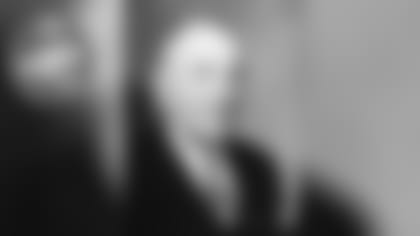Just as Verne Lewellen's dominance of the NFL in the 1920s and early '30s has gone unappreciated partly because his role as a punter under vastly different rules and styles of play doesn't translate to today's game or even the game in 1963 when the first Pro Football Hall of Fame class was selected, Paul Hornung gets slighted for similar reasons.
His stats don't translate to today's game, either.
Reality is that Lombardi, who won more NFL championships in a seven-year period than any other coach ever won in a full decade, built his offense around Hornung and a single play: Red Right 49, Lombardi's signature power sweep. It was the same play that Frank Gifford ran on his career path to the Hall of Fame when Lombardi was an assistant with the New York Giants and built his first pro attack around his left halfback.
While hardly anyone seems to misconstrue Gifford's role in Lombardi's offense, despite him leading the team in carries only once in those five seasons, few today seem to grasp Hornung's place in Lombardi's Green Bay years.
In fact, what's interesting is that author David Maraniss explained the power sweep to a T in Chapter 12 of his book, "When Pride Still Mattered."
Yet John Roach and Zeke Bratkowski, Lombardi's backup quarterbacks, both told me in separate interviews that it was clear to them that the late coaching legend John Madden had failed to grasp how the Packers' entire offense was built and revolved around "Red Right 49" when he told his story about attending a Lombardi clinic early in his career; and that Madden also was off-base when he said Jim Taylor shared carries with Hornung on the power sweep. "(Madden) was a young coach and probably had a lot of questions," Bratkowski told me in 2018. "But that was an exaggeration."
The only real difference between Lombardi's offense in New York and the one he ran in Green Bay was that he used a three-back set with Gifford, Alex Webster at right halfback and Mel Triplett at fullback as his usual starters, but abandoned that scheme eight games into his first season in Green Bay when he replaced his right halfback with a flanker and went with a two-back set.
Just as fullback Taylor got the most carries with the Packers after the 1959 season, so did fullback Eddie Price in 1954, Webster as the right halfback in 1955 and '56, and Triplett as the fullback in 1958 when Lombardi was in New York.
Much like Gifford, Hornung was the ball carrier on "Red Right 49" when he and Taylor were teamed together in the backfield. The play was always run to the right side out of a split-back formation with Hornung lined up behind and just to the inside of the left tackle. If Taylor ran it, it might not have been even once for every 100 plays, according to Bratkowski. "We were breaking tendencies if we did that," he said, not knowing for certain if they ever did.
Hornung also handled the ball on "49 Sweep Pass," Lombardi's playbook name for the halfback option, which was his companion play for "Red Right 49" and also one that he considered critical to the success of his pet play. Taylor occasionally ran a weakside sweep, but that was hardly a staple of Lombardi's big back, power running game.
The fullback's assortment of weakside runs was designed to exploit defenses overplaying the power sweep. Lombardi's famed "Sucker Play" was one. "45 Trap" and "47 Power" were two other Lombardi staples run from split backs designed as alternatives to "Red Right 49" and with the left halfback carrying the ball on both plays.
Even Lombardi's play-action passes and what he called the "Bart Starr Special," "A and B Circle" in the playbook, were designed as offshoots of the power sweep. What's more, "A and B Circle" was a pass play run from split backs that took advantage of Hornung's talents as a receiver. The play called for both the halfback and fullback to circle out of the backfield for passes that traveled roughly five to 15 yards.
Because Hornung was the centerpiece of his offense, the pressure player mostly responsible for two of the Packers' first three NFL titles in the 1960s and the galvanizing leader of the locker room, he was the one and only player that Lombardi called "his greatest." And how foolish would it be to disagree with arguably the greatest coach in NFL history about his own players?
1. Paul Hornung, HB, 1957-62, '64-66 – It wasn't just Lombardi who viewed Hornung as the greatest of the 1960s Packers.
So did many, if not most, of his key players. "Vince called him our money player and he was just that. He should have been the first player from our team in the Hall of Fame," said cornerback Herb Adderley. Guard Jerry Kramer said, "Paul was really the only player we had in Green Bay who came in a superstar and left a superstar." Bart Starr called Hornung "one of the finest clutch players ever."
As for Lombardi's assistant coaches, three of them later scouted for Ron Wolf and told him that Hornung was Lombardi's best player.
Many opponents also were in agreement. "I've always said Hornung was probably the best all-around back in modern-day football," said Pro Football Hall of Fame defensive end Doug Atkins, who played 17 seasons covering the careers of Jim Brown, Gale Sayers except for four games and Gifford following his first two seasons, among others. "(Hornung) could pass. He could run. He could kick. He could catch. He could block. They say, 'Well, he couldn't run as good as so-and-so. He couldn't do this.' I say, 'Who the hell could do all those things?' He could run like hell and do these things in key situations."
Several opposing head coaches were of a similar mind.
Cleveland's legendary Paul Brown, who had two future Hall of Fame backs of his own, Brown and Bobby Mitchell, gave the Packers' tandem the edge over his because "Hornung can get out and block and it helps Taylor." When the Packers finished 11-2-1 and lost the Western Conference by a half-game to the Bears in 1963, with Hornung suspended for gambling, Minnesota coach Norm Van Brocklin said, "The difference between the Packers with Hornung and without him is the difference between first and second place."
What is often overlooked is that Hornung was an outstanding athlete, good enough to play a year of college basketball at Notre Dame. He also was an exceptional blocker and pass receiver, who averaged 11.4 yards on 130 career catches, or almost three yards more per catch than Christian McCaffrey, maybe the closest comparable to Hornung in today's game.
In 1960, Hornung scored 176 points in 12 games, a record that stood for 46 years, long after the schedule was expanded to 14 and then 16 games, as the Packers won their first conference title under Lombardi.
The next year, he was the MVP of the regular season and MVP of Lombardi's first NFL championship victory, despite not practicing because of Army duty for basically half a season. Even in 1962, when a knee injury limited his contributions, Hornung made the biggest offensive play of the Packers' 16-7 title-game victory over the Giants, when his 21-yard option pass set up their only TD.
In 1965, with the Packers' offense mired in a deep slump – it had scored 13 points or less in five of the previous seven games – and their postseason hopes riding on a game against the Baltimore Colts on the second-to-last weekend, Hornung returned after missing two of the previous three games with an injury and scored five touchdowns, including on pass receptions of 50 and 65 yards, to spark a 42-27 victory. With Hornung playing sparingly, again, due to injuries, the Packers settled for a tie in the final regular-season game, forcing a playoff, and then barely winning that 13-10. The next week, Hornung returned to form and rushed for 105 yards, averaging 5.8 per carry, and scored the clinching touchdown on a 13-yard run in a 23-12 victory over Cleveland in the NFL title game.
Like many great running backs, the only area where Hornung falls short is longevity due to a lingering neck injury that he first suffered in 1960, a nagging knee injury that he suffered in 1962 and his year's suspension. Otherwise, he was the one playmaker who consistently delivered in the biggest games on Lombardi's first three championship teams.
2. Bart Starr, QB, 1956-71 – In 1960, when the Packers decisively outgained Philadelphia, but lost in the NFL championship, Starr later admitted it was largely because Van Brocklin, then the Eagles' quarterback, had outplayed him. In 1961 and '62, when the Packers won their first two league championships under Lombardi, Starr was a supporting actor with a combined 28 touchdown passes and 25 interceptions. In 1964 and '65, Starr was sacked 76 times for 626 yards, partly because of his limited athletic ability. In '65, he also was twice benched by Lombardi in games against the 4-10 Los Angeles Rams, where the Packers scored a total of 16 points in gaining a split.
But Starr eventually proved all the doubters wrong, including his own coach, when he became the first quarterback in history to lead his team to three straight NFL championships under a playoff format. In the process, Starr was named the NFL's MVP in 1966, won the Ice Bowl with his late drive for the ages in 1967 and earned MVP honors in the first two Super Bowls.
At a time when quarterbacks called their own plays, Starr was the consummate field general. What he lacked physically, he more than made up for over time with his preparation, play-calling, mental toughness and his tireless effort to improve on his passing and especially his touch, which Lombardi once criticized, to arguably throw the most catchable passes of any quarterback in the league.
"Johnny Unitas has been a great, great, great quarterback," Lombardi said in February 1970, only months before his death. "But Starr did the winning in the 1960s. And that is the object – to win."
"Bart Starr is in a class by himself," no less an authority than Hall of Fame coach Sid Gillman, nicknamed "The Father of the Modern Passing Game," said after Super Bowl I. "He has been ahead of Unitas for a long time. Nobody can touch him; he's as good as there ever has been. The thing about him is that once he finds something he wears it out. Show him a weakness and he'll exploit it, hammer it, beat it to death."
3. Jim Taylor, FB, 1958-66 – From 1959, Lombardi's first season, to 1964, the Packers led the league in rushing three times, finished second twice and third once. In turn, Taylor rushed for more than 1,000 yards five straight years from 1960-64. He wasn't big or fast. He wasn't the receiver or blocker that Hornung was, but Taylor was the bell cow of a running game that carried the Packers to their first two NFL titles under Lombardi.
The great Night Train Lane, a 6-foot-2, 210-pound cornerback famous for his now outlawed necktie tackles, said in 1963, the 12th of his 14 seasons, that the four toughest players he had to tackle were Willie Galimore of the Bears, Taylor and Hornung, and Brown.
Taylor was the league's MVP in 1962 and MVP of the 1965 NFL title game, although he might have been more deserving in '62 when he carried 31 times for 85 yards as the Packers withstood the Giants in a brutal defensive game played in numbingly cold weather on what that day was Yankee Stadium's butcher board of a field. Afterward, Giants middle linebacker Sam Huff said, "Taylor isn't human. No human being could have taken the punishment he got today."
4. Herb Adderley, CB, 1961-69 – When Adderley was elected to the Pro Football Hall of Fame in 1980, I asked Don Shula, who remains the winningest coach in NFL history, to compare him to Lane, the standard by which all cornerbacks were measured at the time. "I coached Night Train as an assistant at Detroit and he was a great corner, and Adderley reminded me of Night Train," Shula answered. "They were great hitters, smart and played the ball well."
Pro Football Hall of Fame receiver Raymond Berry echoed his coach's sentiments almost 30 years later, singling out Lane and Adderley as the two elite corners that the Colts faced in his day. "They were the ones receivers feared most," said Berry.
Adderley was a shutdown corner before it became part of pro football's lexicon – for example, he didn't allow a single touchdown pass in the regular season when the Packers won the 1965 NFL title – and also the game's most physical corner both in coverage and against the run in the eyes of some of the game's best receivers of his day.
"I played against all of them," said Johnny Morris, a flanker for the Chicago Bears from 1958-67 and the NFL's leading receiver in 1964 with 93 catches. "(San Francisco's) Jimmy Johnson was a great defensive back. So was Night Train Lane. I could do things against them. Herb was in a class by himself. I don't have to think about it – he was the best."
Adderley also was a defensive playmaker who made some of the biggest interceptions in Packers history, including a last-minute interception to beat Detroit in 1962 in what might have been Lombardi's biggest regular-season win and his game-clinching 60-yard return for a touchdown in Super Bowl II. Still today, Adderley holds the Packers' record for most interceptions by a cornerback with 39.
5. Willie Wood, S, 1960-71 – Willie Davis was defensive captain of the Packers when they made history with their third straight NFL championship under a playoff format. Ray Nitschke was the toothless, frightful face of the defense from his middle linebacker position. But guard Jerry Kramer wrote in his book, "The Green Bay Diary," that Wood was the feared boss of it on the field.
"Next to Lombardi, Wood scares his own teammates more than anybody else does," Kramer wrote.
Wood was a fearless and sure tackler, a quick-thinking and quick-reacting centerfielder, and a gifted ballhawk who finished his career with 48 interceptions for second place on the Packers' all-time list. "The backbone of the defense," was how Pat Peppler, Lombardi's personnel director, described Wood. Dave Hanner, who spent 44 years in the NFL as a player, coach and scout, said, "I think Willie Wood was as good a tackler as I've ever seen."
6. Ray Nitschke, MLB, 1958-72 – Today's pundits haven't treated Nitschke well because he was selected for only one Pro Bowl and made the Associated Press All-Pro team only twice, but that was partly because future Hall of Famers Joe Schmidt of Detroit and Bill George of the Bears were in the prime of their careers when Nitschke broke into the league; and Dick Butkus, considered by many the greatest middle linebacker in the history of the game, arrived on the scene in 1965. Moreover, they all played in the Western Conference and there was a period when Pro Bowl teams selected only one middle linebacker.
Still, when Lombardi addressed the subject of playmakers in his 1963 book, "Run to Daylight," he wrote, "When you are flat, you're always looking for that big play or that big man who will bring you out of it … Ray Nitschke has a lot of this on the defense for us…" Phil Bengtson, defensive coach for nine years under Lombardi, also told me in 1986 that he'd rate Nitschke his best defender. On the other hand, Bears tight end Mike Ditka said in 1963 that Nitschke was overrated and a level below Schmidt and George. "Nitschke simply tries to overpower," said Ditka. "Take George and Schmidt out of their teams' defense and they'd collapse."
7. Willie Davis, DE, 1960-69 – Had sacks been recorded as an official statistic when Davis played, he almost certainly would be the Packers' all-time leader and well ahead of Clay Matthews, who finished with 83½. Unofficial counts based on play-by-plays and film reviews put Davis' total at upwards of 100.
As the left end defending against an opponent's strong-side running game, Davis was both stout and steady. Yet at the same time, he was a playmaker as a pass rusher. Perhaps his most memorable performance came in the 1961 NFL Championship when the Giants tried three different right tackles in their futile effort to block him.
Upper body strength and a combination of quickness and agility were traits that made Davis special. "Davis is the quickest defensive end in the business," Bears quarterback Bill Wade said in 1963. "He's not the strongest or the biggest, but he's always in there, always managing to get at least his arms in the way." Linebacker Dave Robinson, who played behind Davis on the left side, added, "He was so strong in the chest, he could hit the tackle and control them. Throw them or drive them."
8. Forrest Gregg, T, 1956, '58-70 – When the Packers won their first two titles under Lombardi, Roach, Starr's backup, called the offensive line "the crown jewel of our team." And that may well have been true. Three starters – Gregg, Kramer and center Jim Ringo – were inducted into the Pro Football Hall of Fame. Also, Gregg, an eight-time Pro Bowl selection, was generally recognized as the best of the bunch.
But Lombardi avoided singling out any of them in his text in two books. "The individuals on that offensive line … were all talented, but their greatness was as a team, one single driving force that over the years proved itself in so many winning games," he wrote in "Vince Lombardi on Football."
In "Run to Daylight," Lombardi said Gregg was big enough at 6-4, 230, but not as strong as Bob Skoronski and Norm Masters, his other two tackles. "(Gregg's) a fine downfield blocker, too," Lombardi added. "His speed isn't great but he's very quick off that ball and he has that mental sharpness to adjust quickly to sudden situations. He has that knack of getting in front of the runner and with his excellent sense of timing, of making the key block."
9. Dave Robinson, OLB, 1963-72 – Robinson didn't become a starter until 1965 so he contributed to only three of Lombardi's titles. But one could argue that the Packers might not have won any of the three without Robinson's big plays in big games.
In 1965, the Packers would have been eliminated from the playoffs before the final week of the regular season if they hadn't beaten Baltimore. With less than a minute to play in the first half, the Colts had the ball at the Packers' 2-yard line and were poised to take the lead when Robinson leaped high in the air, intercepted a pass and returned it 87 yards, setting up a touchdown on the next play that resulted in a 14-point swing.
A year later in the NFL title game, Dallas was trailing the Packers, 34-27, but had possession at the Green Bay 2 with 45 seconds remaining and a chance to force overtime. Robinson charged quarterback Don Meredith as he rolled right, collared him high and caused him to throw a pop-fly interception.
In 1967, the Packers faced the Rams in a conference championship and were home underdogs. The Rams jumped ahead, 7-0, and had a chance to expand their lead early in the second quarter when they lined up for a 24-yard field goal try. Robinson blocked the kick in what turned out to be a 28-7 victory. Afterward, Rams coach George Allen called the block the turning point of the game. "If we score at all down there, we win," he said.
If this list took into account Robinson's play over the remainder of his Packers career, he'd also be higher on this list. Hanner, who played with and coached both Robinson and Nitschke throughout their careers in Green Bay, once told me, "I know people think I'm crazy, but if you had to pick between Nitschke and Dave Robinson, I'd take Dave Robinson."
10. Henry Jordan, DT, 1959-69 – At 248 pounds, Jordan was vulnerable against the run. But great inside pass rushers are still a rarity today. How many Aaron Donalds are there? That partly explains why the Packers didn't have a repeat Pro Bowl defensive tackle between Jordan and Kenny Clark, a span of more than 50 years.
Jordan was so quick, so relentless and so disruptive as an inside rusher that future Hall of Fame quarterback Y.A. Tittle said he was the key to the Packers' defense when they beat the Giants in back-to-back championship games in 1961 and '62.
"(The Packers) have put together what seems to be man-for-man the perfect 4-3," Tittle told renowned photographer and author Robert Riger after the '62 title game. "And the key to it all is one man, Henry Jordan. Where in all of football can you find a pass rusher at tackle like this man? You usually find them at ends. Henry Jordan is the best tackle in football – perhaps the best in the history of the NFL."
Jordan dealt with back problems late in his career but in 1967, Lombardi's final championship season, he embarrassed future Hall of Fame guard Tom Mack in the Western Conference playoff against the 11-1-2 Rams, who might have been the most talented of the Packers' three postseason foes that year. Although sacks weren't an official stat, Jordan was credited by various sources with either 3½ or 4 against Mack.
"He is the best tackle outside of (Bob) Lilly that I ever played against," Dallas guard John Niland said the next week as he watched film of Jordan annihilating Mack and prepared to face him. "Henry's big asset is quickness. I've never seen anyone move so fast."














